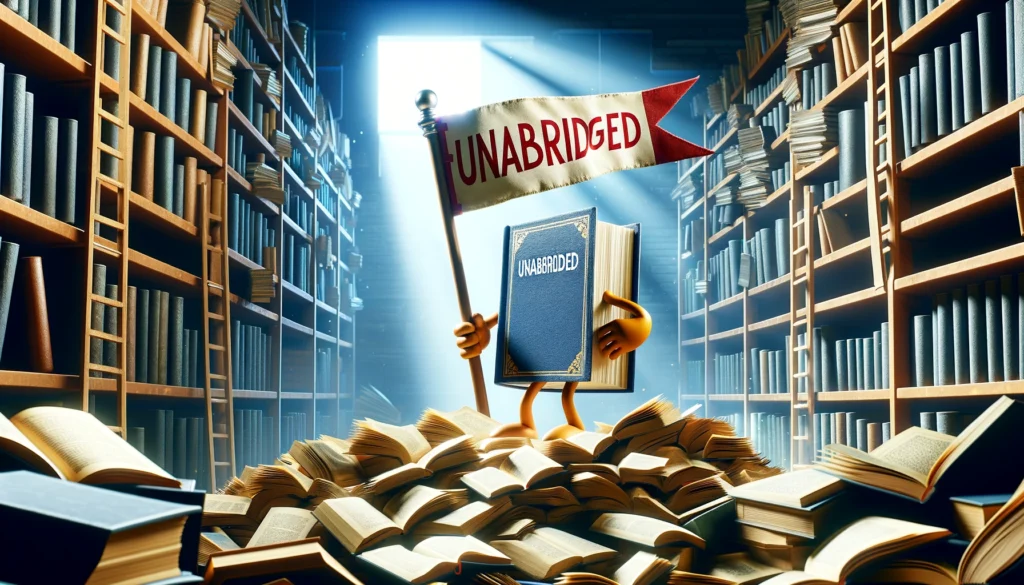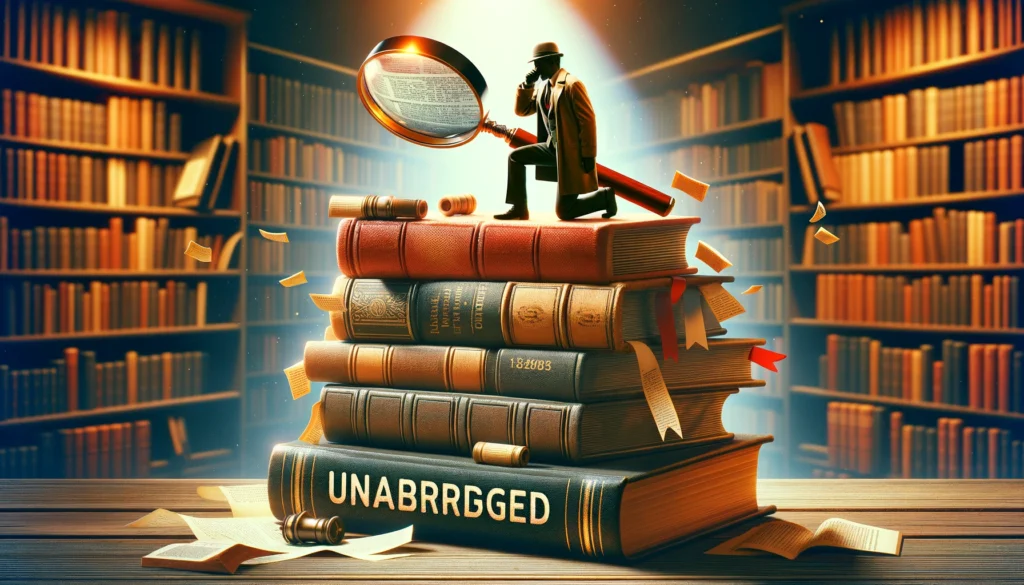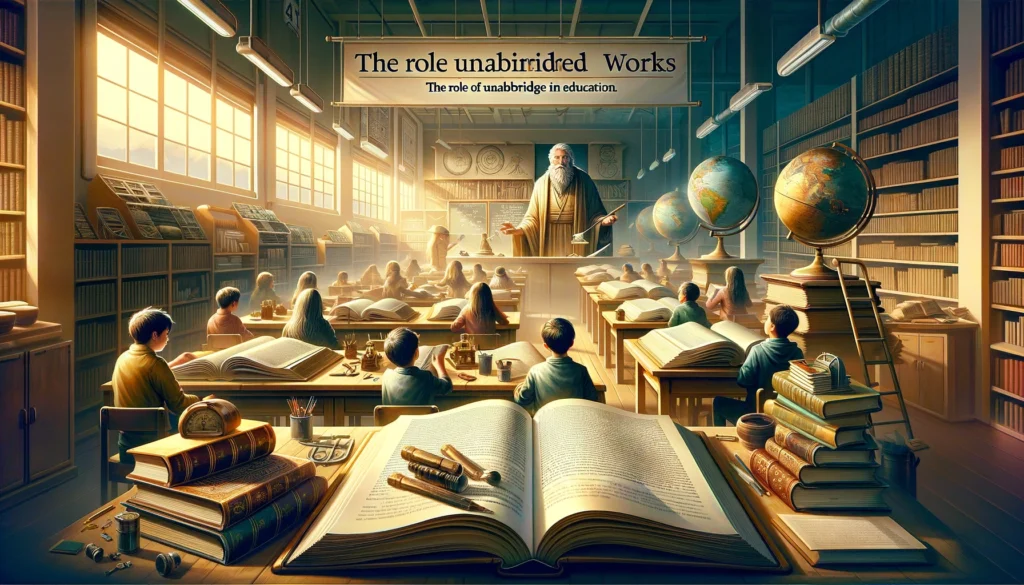Ever found yourself flipping through a thick book and noticing it’s labeled “unabridged”? What does unabridged mean, anyway? It’s one of those terms you see now and then, especially if you love diving into books and literature.
Unabridged means the content you’ve got in your hands is the full version, nothing cut out or edited down. It’s the author’s complete work, with every word they intended to share with you.
Why does this matter? Well, whether you’re a casual reader, a student, or someone who loves getting lost in stories, understanding the difference between unabridged and abridged can really shape your reading experience. Let’s explore why choosing unabridged might just be the best decision for your next literary adventure.
What Does Unabridged Mean?

So, what does unabridged mean exactly?
To put it simply, when you pick up an unabridged book, you’re getting the whole story, exactly as the author penned it. There’s not a single scene skipped, no dialogue edited out, and no descriptions trimmed down. It’s all there, from the first word to the last.
Now, let’s look at the flip side with “abridged.” Abridged books are like the shorter, condensed versions of their original counterparts.
Think of them as the highlight reels of literature. In abridged versions, editors trim down the content to make it quicker to read, focusing on the main plot points and removing parts that they consider less essential.
This can include cutting down on lengthy descriptions, secondary storylines, or even entire chapters.
Understanding the difference between unabridged and abridged is key. While unabridged lets you experience the work as it was originally created, abridged offers a quicker, more accessible version.
Whether you’re in it for the full experience or just want to get to the heart of the story, knowing which version you’re holding can make all the difference in your reading journey.
The Importance of Unabridged Texts

Choosing an unabridged version of a text can be like opting for the scenic route on a road trip. You’re not just trying to get from point A to point B; you’re in it for the full experience, the landscapes, the hidden gems, and all the nuances of the journey.
For avid readers, scholars, and those who crave depth, unabridged texts offer that complete, immersive dive into the author’s world.
For students and researchers, the unabridged text is invaluable. It provides the full context, the nuanced arguments, or the detailed historical account necessary for a thorough understanding of the subject.
Missing out on a single paragraph might mean overlooking a crucial piece of evidence or a pivotal moment in a narrative.
And then, there are the literature enthusiasts. For those of us who cherish every word of our favorite authors, the thought of missing out on even a single sentence is almost sacrilegious.
Unabridged texts preserve the author’s original voice, the rhythm of their prose, and the intricacy of their storytelling. It’s about respecting the integrity of the work and experiencing the story as it was meant to be told, in all its glory.
Choosing unabridged isn’t just about not missing out; it’s about honoring the artistry of writing and the depth of human thought. It’s for those moments when you want to delve deep, understand fully, and appreciate the work in its most authentic form.
Unabridged in Literature
When we talk about unabridged in literature, we’re talking about keeping the soul of the story intact.
Unabridged works are the literary world’s way of ensuring that every word the author thought important enough to write down makes its way to you, the reader.
This is about more than just preserving content; it’s about upholding the author’s original intent, their tone, and the subtle nuances that give a story its depth.
Take, for example, classic novels like “Les Misérables” by Victor Hugo or “War and Peace” by Leo Tolstoy. These mammoth works are known not just for their compelling narratives but also for their detailed explorations of history, philosophy, and the human condition.
Reading an abridged version of these novels might give you the plot’s skeleton, but you’d miss out on the flesh and blood of the story, the rich details, and the author’s full vision. It’s the difference between looking at a photo of a masterpiece painting and seeing it in person, in all its detailed glory.
Unabridged Dictionaries and Reference Materials
Now, let’s shift gears to unabridged dictionaries and reference materials. For anyone serious about digging deep into a language or field of study, these resources are indispensable.
Unabridged dictionaries offer not just definitions but also the etymology, usage examples, and nuances of words. They’re a treasure for language learners, writers, and anyone with a love for the depth and breadth of language.
For students and researchers, unabridged reference materials provide the comprehensive detail needed for rigorous academic work.
Whether it’s a historical text, a scientific encyclopedia, or a specialized handbook, having access to unabridged materials means getting the full spectrum of information. It’s like having a direct line to the experts and the original sources, without any filtering or oversimplification.
In essence, unabridged dictionaries and reference materials are about empowerment. They empower users with a complete understanding, a broader vocabulary, and a deeper insight into their subject matter.
For anyone looking to truly master a language or field, these resources are the gold standard, offering clarity, depth, and precision.
Choosing Between Unabridged and Abridged

Choosing between unabridged and abridged texts can feel a bit like deciding between a full-course meal and a snack. Both have their moments, depending on your appetite and time.
So, when do you go for the full spread, and when is a quick bite the better option?
Go Unabridged When:
- You’re Studying or Researching: If you’re diving deep into a subject, whether for academic, professional, or personal reasons, unabridged is the way to go. You’ll want every detail, every argument, and every example the author originally included. It’s about getting the complete picture without missing any nuances.
- You’re Reading for Pleasure: If you’re settling in with a book by your favorite author or tackling a classic, and you want to savor every word, choose unabridged. This is your chance to experience the story as the author intended, with all its complexity and beauty.
- You Appreciate the Art of Writing: For those who love language and the craft of writing, unabridged works offer a full display of the author’s skill. You’ll see how they build worlds, develop characters, and weave themes throughout their work.
Opt for Abridged When:
- You’re Short on Time: If you’re curious about a story but can’t commit to the length of the unabridged version, an abridged book can give you the essence of the plot and the characters without the same time investment.
- You’re Exploring a New Genre: If you’re dipping your toes into a genre you’re not familiar with, starting with an abridged version can be a less daunting way to explore new literary landscapes.
- You’re Introducing Young Readers to Classics: Sometimes, the unabridged version of a classic might be too dense for younger readers. Abridged versions can serve as accessible introductions, sparking an interest that leads them to the full versions later on.
Finding Unabridged Versions

Hunting for unabridged versions of books can be a bit of a treasure hunt, but oh, what a reward when you find that untouched gem!
Here are some tips to help you navigate your way to the unabridged treasures you’re after:
- Check the Publishing Details: This might seem basic, but it’s your first clue. Look for words like “unabridged” on the cover or in the book’s description. Publishers often highlight this to distinguish it from abridged versions. If you’re shopping online, this information is usually listed in the product details or description section.
- Visit Specialized Bookstores: Independent and used bookstores often have a wide selection of classics and hard-to-find editions, including unabridged versions. The staff can be incredibly knowledgeable and helpful in guiding you to what you’re looking for.
- Use Library Resources: Libraries are gold mines for unabridged texts, especially if you’re looking for literary classics or academic materials. Many libraries also offer access to digital resources where you can borrow unabridged e-books or audiobooks.
- Online Retailers and Marketplaces: Websites like Amazon, AbeBooks, and eBay can be great places to find unabridged versions of books. Use the search filters to narrow down your options to “unabridged” editions. Reading customer reviews and questions can also give you insight into whether the version you’re considering is unabridged.
- E-book Platforms: If you’re a digital reader, platforms like Kindle, Nook, and Apple Books offer unabridged versions. Again, the key is to look for the “unabridged” label in the book’s details before purchasing.
- Audiobook Services: For audiobook lovers, services like Audible often specify whether an audiobook is unabridged. This is crucial because you’ll want to ensure you’re getting the full listening experience, especially for novels and non-fiction works.
The Role of Unabridged Works in Education

When it comes to education, the role of unabridged works cannot be overstated. In academic settings, using unabridged texts is like giving students a map of knowledge, in its entirety, without shortcuts.
This approach has a profound impact on learning and comprehension, shaping not just how much students learn, but how deeply they understand and engage with the material.
Using unabridged texts in the classroom allows educators to expose students to the richness of language, the complexity of plot development, and the depth of character analysis. It’s about more than just the story or the information; it’s about experiencing the author’s original voice and intention.
This full exposure helps students develop critical thinking skills as they analyze and interpret the text, encouraging them to delve into nuances and subtleties that abridged versions might omit.
Moreover, unabridged works challenge students to stretch their reading abilities and vocabulary, fostering a deeper appreciation for literature and a stronger grasp of language.
This challenge is essential in academic growth, pushing students to expand their boundaries and explore complex ideas and themes. It prepares them not only for academic success but also for lifelong learning, instilling a curiosity and respect for literature and knowledge.
In addition, unabridged texts provide a more authentic context for discussions and analyses, enabling a comprehensive exploration of cultural, historical, and philosophical perspectives.
This context enriches the educational experience, offering students a multidimensional understanding of the material. It encourages them to connect dots across disciplines, enhancing their ability to think critically and creatively.
The use of unabridged works in education also underscores the importance of intellectual integrity and respect for the author’s work. It teaches students to value the originality and effort behind literary works and scholarly texts, fostering a culture of appreciation for intellectual property and artistic expression.
In essence, incorporating unabridged texts into academic settings is about offering students a complete, unfiltered access to knowledge and creativity. It’s an investment in their intellectual development, equipping them with the tools to think, analyze, and appreciate more deeply.
Conclusion
Understanding what does unabridged mean opens up a world of literary richness and integrity. It’s about experiencing works in their most authentic and complete form, whether for pleasure, study, or research. Choosing unabridged texts allows us to connect deeply with the author’s original vision, embracing the full scope of their creativity and insight.
As readers, learners, and thinkers, using unabridged works enriches our understanding and appreciation of literature and learning, bridging the gap between mere content consumption and profound intellectual engagement.
FAQ
What does it mean when a book is unabridged?
An unabridged book is presented in its original, complete form without any cuts or edits. It includes all the content the author intended, offering readers the full story or information as originally written.
Does unabridged mean complete?
Yes, unabridged means complete. It refers to texts that are presented in their entirety, without any sections removed or altered from the original manuscript.
What is the literal meaning of unabridged?
Literally, unabridged means not shortened. It refers to texts that are fully intact, with no parts removed or edited out, ensuring that the content is presented as the author originally intended.
What is the opposite of unabridged?
The opposite of unabridged is abridged. Abridged texts have been shortened or condensed, often to make them easier to read or more accessible, but at the cost of removing some original content.
Is unabridged better than abridged?
Whether unabridged is better than abridged depends on the reader’s needs. Unabridged works offer a complete, authentic experience, while abridged versions are more concise and accessible, but might omit significant details.
What is a synonym for unabridged?
A synonym for unabridged is complete or full. These terms convey the idea of a work that is intact and unaltered, presenting all the original content as the author intended.
What would you call a book that is complete and not abridged?
A book that is complete and not abridged would be called an unabridged book. This means it contains all the original content without any edits or omissions.
What does unabridged mean in audio books?
In audio books, unabridged means the recording contains the entire content of the book as written by the author, with no parts omitted or condensed.
Abridged vs unabridged meaning?
Abridged refers to texts that have been shortened or condensed, usually for ease of reading, while unabridged means the text is complete and unaltered, containing all the original content.

